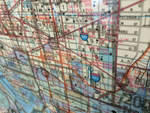In 1970, before the opening of Walt Disney World, Orlando was still a tourism center, attracting 660,000 people a year. But by 1999, the place was a powerhouse, with 37.9 million visits, and in 2016, that number hit 68 million. The area population also leapfrogged from 344,000 to 860,000 to 2.38 million, passing old-guard American cities as St. Louis; Washington, D.C.; Boston; Baltimore; and Portland.
However, for all that growth, and despite the fact the amusements are critical to Orlando’s economy, most of the population still lives north of SeaWorld. The tourist zones are segregated from residential ones. Huge chunks of your time, days at a stretch, will be spent only in the boisterously inauthentic commercial corridors. Those lie along International Drive, U.S. 192 around I-4, and the Lake Buena Vista area north of exit 68 off I-4.
The Making of a Kingdom
Back when only cargo trains had much business in Central Florida, Orlando fashioned itself as a prosperous small city—some derisively called it a cow town—well positioned to serve the citrus and cattle industries as they shipped goods between America and Cuba. The city remained that way, mostly irrelevant, until around 1943, when the great cross-state cattle drives ended.
Soon after, the brick-warehouse city of Orlando developed its second personality. The turning point wasn’t the arrival of Walt Disney on his secret land-buying trips. It came a decade earlier, when NASA settled into the Space Coast, 45 minutes east, and the local government, spotting opportunity, invited the Martin Marietta corporation—now Lockheed Martin—to open a massive facility off Sand Lake Road, near the present-day Convention Center. To sweeten the deal, leaders promised unprecedented civic improvements, including an unrealized high-speed rail system they’re still dithering over. Mostly, though, politicians built roads. Florida’s Turnpike to Miami was carved past the Martin plot, S.R. 50 was hammered through downtown to link the coasts, and, soon after, many blocks were bulldozed for the construction of I-4, linking Tampa on the west coast with Daytona Beach (then one of America’s premier vacation towns) on the east coast. The new transit links had Walt licking his chops for some cheap land nearby.
Florida’s politicians on both the left and right fell over themselves to convince Walt to build his new kingdom there. Because Disney’s new kingdom was to be constructed 20 miles southwest of the city in empty scrubland, where the tax base couldn’t afford to build the infrastructure that would be required, 1967 politicians in Tallahassee created a special district that empowered Disney to shoulder the burden of funding and building improvements like roads and drainage canals. The resort was intended to be an oasis in the citrus groves, but soon, sprawl and poor development sprouted around the park’s border, just as had happened in Anaheim. For the last two generations, the space between Orlando’s two disparate neighborhoods has vanished, consumed by areas where “real” Orlando residents live, so that the old-fashioned, “traditional” city has come to be dwarfed, as it were, by family-friendly honky-tonk and slapped-up suburbs. Few casual visitors ever lay eyes on the real Orlando—a situation the theme parks’ accountants like just fine.
The Pulse massacre
In the early morning hours of June 12, 2016, a gunman bearing a legally obtained AR-15 entered Pulse, a gay nightclub just south of downtown Orlando, and began systematically murdering people he didn’t know. By the time police felt it was safe enough to invade, 102 people had been shot, 49 of them mortally. The devastation was profound. Orlando was now home to the deadliest mass shooting in American history (a record that was swiftly surpassed by another one). National outrage sparked an unprecedented shift in the country’s politics—within days, members of Congress staged a sit-in on the House floor to demand a vote on gun control measures. Across Orlando, security tightened, patrols escalated, metal detectors were installed, and for the first time, the world sadly acknowledged that even “The Happiest Place on Earth” was not immune to indiscriminate American violence. Although the nightclub was far from the tourist districts, it was a part of the community. Several of the victims worked at the theme parks—one, Luis Vielma, ran the Harry Potter and the Forbidden Journey ride at Islands of Adventure. Both Universal and Disney donated $1 million to the OneOrlando fund for the affected. Pulse was a watershed event. With it, Florida’s youth reached a breaking point, and after the next major shooting in the state, in Parkland in February 2018, a powerful new political movement was born among Gen Z. Florida youth are now among the nation’s most forceful public proponents of American gun reform.
In June of 2021, President Joe Biden announced that Pulse would be designated an official national memorial, but political resistance, including from some victims’ own family members, has stymied its creation. In the interim, the nightclub at 1912 S. Orange Ave. remains standing, surrounded by grass, benches, and a tribute wall. Ghostly pop music gently plays from hidden speakers (daily 7:30am–9pm). The onePULSE Foundation (www.onepulsefoundation.org) has created a scholarship fund in the name of each of the victims. Wherever you go, whether it’s to a hotel, a restaurant, or a theme park, remember that you will meet people who knew and loved someone whose life was stolen or ravaged by needless ongoing American violence.
Note: This information was accurate when it was published, but can change without notice. Please be sure to confirm all rates and details directly with the companies in question before planning your trip.








